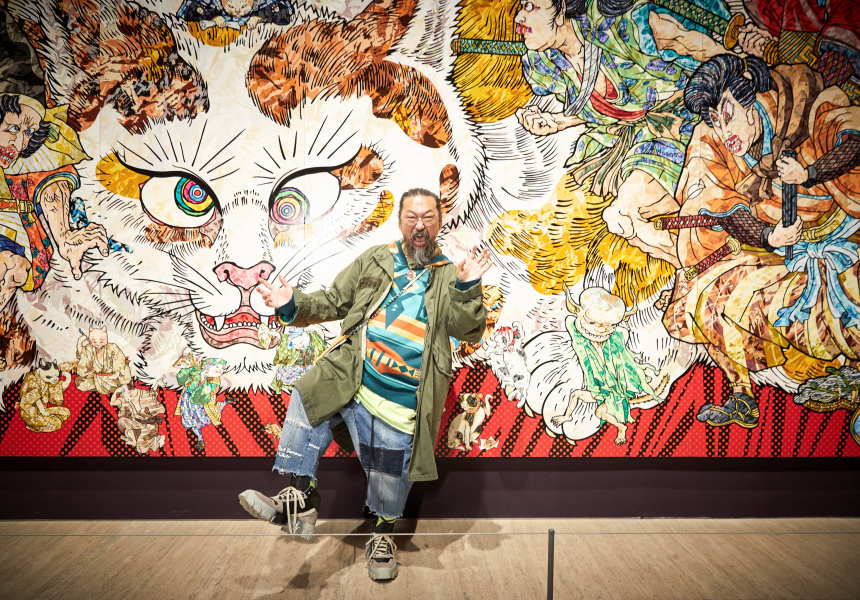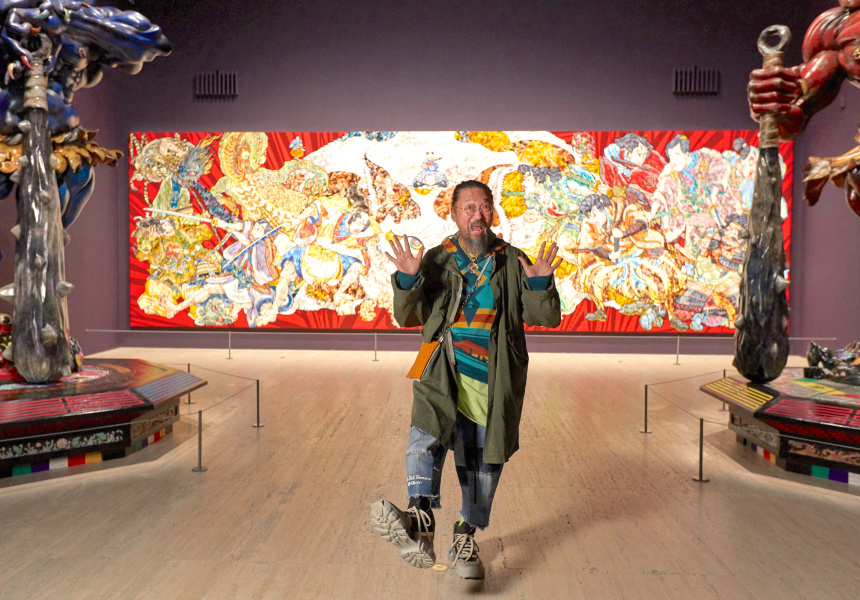At three by 10 metres, Japan Supernatural: Vertiginous After Staring at the Empty World Too Intensely, I Found Myself Trapped in the Realm of Lurking Ghosts and Monsters is the largest single painting to enter AGNSW’s international collection.
The Takashi Murakami piece was commissioned by AGNSW to commemorate the new exhibition Japan Supernatural, which runs through to March 8, 2020. It pays tribute to the landmark show, which features more than 180 wildly imaginative works by Japanese artists from the 18th century to the present. It also references Murakami’s own role as a contemporary artist exploring the imaginative worlds of Japanese art, and confronting the spirits and beings within it.
“This work had a really unique process for me because the museum had quite a specific request for the painting,” Murakami told Broadsheet on the eve of its opening. “The first time I met the curator they told me what kind of work they wanted, so I got a great inspiration to arrive at the overall composition from starting there, and the work really came into being through my back-and-forth exchange with the museum.”
Never miss a Sydney moment. Make sure you're subscribed to our newsletter today.
SUBSCRIBE NOWSeething samurai, writhing yо̄kai (monsters) and a massive feline spirit dominate the work, which consists of 502 individual silkscreens. It’s a vivid, layered composition that references the samurai films of Akira Kurosawa and the ukiyo-e (“floating world”) art that proliferated during the Edo period (1603-1868), especially the works of Utagawa Kuniyoshi (some of which are featured in the exhibition).
As visitors step into the realm of the Japanese supernatural, they’ll find imps, monsters, spirits and paranormal phenomena by the late manga artist Mizuki Shigeru; works by contemporary artists Fuyuko Matsui and Chiho Aoshima; and some of the greatest Japanese artists of the 19th century, including Katsushika Hokusai, Utagawa Kuniyoshi, Tsukioka Yoshitoshi and Kawanabe Kyōsai. Works in the show range from miniature carvings to large-scale installations. There are also masks, humorous illustrations and, of course, the famous ukiyo-e woodblock prints.
Manifestations of the ethereal and other-worldly are prevalent across Japanese folklore, literature, theatre and art. “During the Edo period organised religion was not very present and then Christianity was banned,” explains Murakami. “Rather than being drawn to god, people were really scared of the power of nature, because Japan was always bombarded with natural disasters from earthquakes and heavy rains to tsunamis and typhoons.
“Because the threat of nature was what people feared the most, they tried to create something that would embody that fear, and that became supernatural beings like yо̄kai, enormous cats, a big octopus or a big fish.”
Sourced from museum collections around the world and the AGNSW’s own considerable collection of Japanese art, the calibre and number of works in Japan Supernatural make it the largest and most complex Japanese show in the museum’s history.
“This project is the outcome of extensive discussions [and] has resulted in some of the finest works of Japanese art ever created on display in Sydney,” says AGNSW director Doctor Michael Brand.
To complement the exhibition, the AGNSW is running a series of public events, including a rare talk by Murakami; a lecture series titled Phenomenal beings: spirits in Japanese art and culture; a retrospective of global horror cinema; and a festival focusing on the award-winning Studio Ghibli, which is best-known for its anime films.
Renowned for his pop-culture-infused paintings and sculptures, Murakami is also a curator and collector with a deep knowledge of Japanese art history. He says the show will appeal to art buffs and novices alike.
“For someone like me who is an art professional with a deep curiosity in Japanese culture, this show is extremely interesting, because there’s normally very little focus on supernatural art and yо̄kai,” he explains.
“The curators have really delved into it to explore Japanese religious sentiment and the people’s relationship with nature, so people who want to learn in detail about the culture will definitely enjoy it, but it’s packaged so the general audience will really enjoy it too.”
Japan Supernatural is at the AGNSW until March 8, 2020. For the last weekend, Friday 6 March to Sunday March 8, the gallery is open late, until 10pm. More details here.



